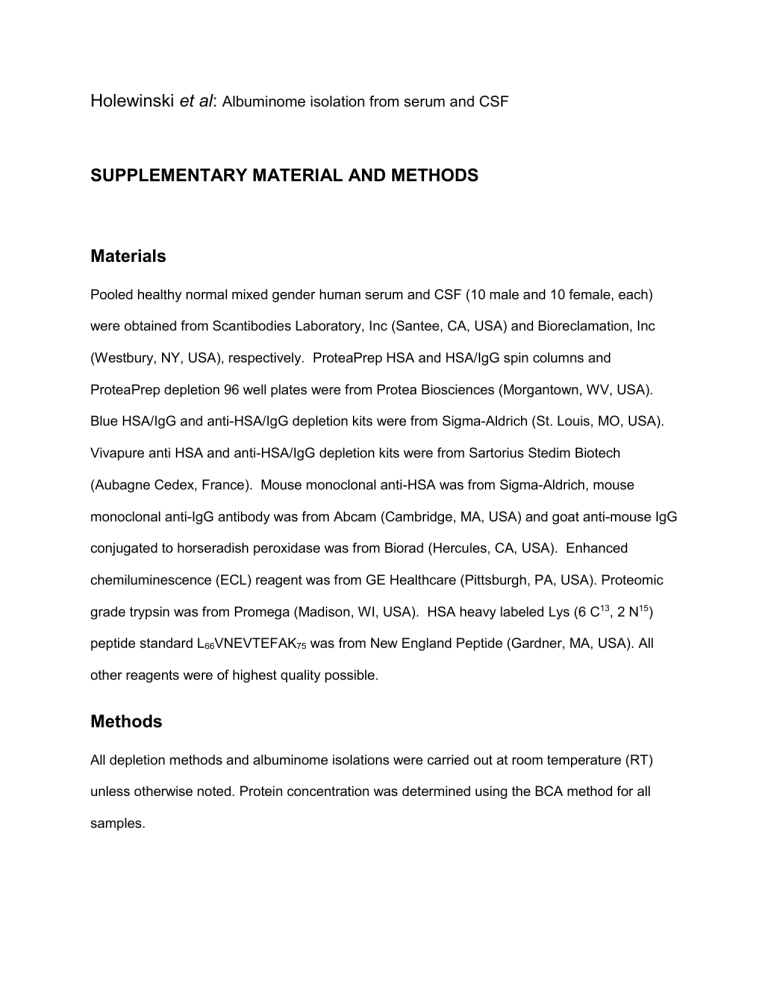pmic7336-sup-0001-S1

Holewinski et al : Albuminome isolation from serum and CSF
SUPPLEMENTARY MATERIAL AND METHODS
Materials
Pooled healthy normal mixed gender human serum and CSF (10 male and 10 female, each) were obtained from Scantibodies Laboratory, Inc (Santee, CA, USA) and Bioreclamation, Inc
(Westbury, NY, USA), respectively. ProteaPrep HSA and HSA/IgG spin columns and
ProteaPrep depletion 96 well plates were from Protea Biosciences (Morgantown, WV, USA).
Blue HSA/IgG and anti-HSA/IgG depletion kits were from Sigma-Aldrich (St. Louis, MO, USA).
Vivapure anti HSA and anti-HSA/IgG depletion kits were from Sartorius Stedim Biotech
(Aubagne Cedex, France). Mouse monoclonal anti-HSA was from Sigma-Aldrich, mouse monoclonal anti-IgG antibody was from Abcam (Cambridge, MA, USA) and goat anti-mouse IgG conjugated to horseradish peroxidase was from Biorad (Hercules, CA, USA). Enhanced chemiluminescence (ECL) reagent was from GE Healthcare (Pittsburgh, PA, USA). Proteomic grade trypsin was from Promega (Madison, WI, USA). HSA heavy labeled Lys (6 C 13 , 2 N 15 ) peptide standard L
66
VNEVTEFAK
75 was from New England Peptide (Gardner, MA, USA). All other reagents were of highest quality possible.
Methods
All depletion methods and albuminome isolations were carried out at room temperature (RT) unless otherwise noted. Protein concentration was determined using the BCA method for all samples.
Capture/depletion of HSA from human serum and cerebrospinal fluid using ProteaPrep
HSA spin columns
Pooled human serum and pooled human CSF were depleted of HSA using the ProteaPrep spin column (technical replicate=3 for each). Briefly, columns were activated using 400 µL of activation buffer (10 mM PBS), vortexed to suspend the beads into the solution, incubated for 5 minutes with shaking and then centrifugation at 6000 rpm for 3 minutes. Human serum and
CSF were diluted with activation buffer up to a total volume of 400 µL (10 µL serum and 100 µL of CSF were used), added to the activated beads, vortexed and incubated for 5 minutes with shaking. Columns were centrifuged as described above and depleted serum and CSF were collected in clean tubes and the bound fraction was obtained as described below.
Depletion of HSA from human serum using ProteaPrep depletion plate
The plate was activated by adding 150 µL of bead activation buffer to each of the 96 wells and pulling buffer through using a vacuum manifold (Waters, Milford, MA, USA). Samples were prepared by treating 3 µL of human serum and treating with 147 µL of the activation buffer.
Samples were then added to the beads in each well and drawn straight through the column once, twice, or three times.
Depletion of HSA and IgG using multiple depletion methods
The following procedures are slight modifications of the protocols provided by the manufacturers. Detailed information about buffer compositions can be found on the manufacturer’s websites.
Control (no depletion) sample. Control samples (no depletion) were prepared by mixing 10 µL of serum a nd 100 µL of CSF with 390 µL and 300 µL of 10 mM PBS, respectively.
ProteaPrep HSA/IgG depletion columns. HSA and IgG were depleted from human serum using
ProteaPrep HSA/IgG columns in the same manner as described above for the Protea HSA columns.
Protein G-NaCl/EtOH depletion method. HSA and IgG were depleted from human serum according to the protocol previously described [1]. The pellet obtained after precipitation with
NaCl/EtOH was resuspended in 300 µL of 8M urea and heated at 55 °C for 30 minutes.
Samples were centrifuged at 16,000 g for 15 minutes and the lipid layer that formed on top was removed.
Vivapure anti-HSA and anti-HSA/IgG depletion kit. A clarification spin column was filled with 440
µL of Vivapure anti-HSA or anti-HSA/IgG affinity resin, containing 50% packed material, followed by addition of 20 µL human serum. Sample was incubated for 15 minutes at room temperature on a rotary shaker with gentle mixing. Column was centrifuged at 400 g for 1 minute and flow through was collected in a clean tube. A dded 200 µL of Binding Buffer to the spin column and incubated for 2 minutes on a rotary shaker. Centrifuged at 400 g for 1 minute and collecting the flow through, combining with the flow through from the first centrifugation.
Sigma Blue HSA/IgG depletion kit. Medium was resuspended by gently swirling the slurry until no medium remained on the bottom then 400 µL of this was transferred to a spin column.
Columns were centrifuged at 8,000 g for 10 seconds to remove the storage solution. Added
400 µL of equilibration buffer to the medium in the spin column and centrifuged at 8,000 g for 10 seconds, repeating this equilibration step once. Added 25 µL of serum to the top of the packed medium and incubated at room temperature for 10 minutes. Centrifuged the spin column at centrifuged at 8,000 g for 1 minute and collected the flow through in a clean tube. Washed column twice with 100 µL of equilibration buffer and centrifuged at 8,000 g for 1 minute, combining all three flow through fractions.
Sigma anti-HSA/IgG depletion columns. Columns were centrifuged at 5,000 g for 10 seconds to remove the storage solution. Added 400 µL of equilibration buffer to the medium in the column and centrifuged at 5,000 g for 10 seconds, repeating this step two more time s. Diluted 35 µL of serum and 100 µL of CSF with 65 µL and 100 µL, respectively, and added the diluted sample to the top of the column and incubated at room temperature for 10 minutes. Centrifuged at 8,000
g for 1 minute, reapplied eluate back to the column, incubated for an additional 5 minutes and centrifuged at 8,000 g for 1 minute. Washed column with 200 µL of equilibration buffer and centrifuged at 8,000 g for 1 minute, combining the flow through fractions from the binding and wash steps.
Release of albuminome from ProteaPrep HSA columns and Vivapure anti-HSA columns
HSA was captured using ProteaPrep HSA and Vivapure anti-HSA columns as described above.
For ProteaPrep HSA columns, c olumns were washed twice with 400 µL of activation buffer and albuminome was released by addition of 400 µL 25% acetonitrile, 5% formic acid and incubation for 5 minutes with shaking. Columns were centrifuged as described above and albuminome collected. For Vivapure anti-HSA columns, column was washed with an addi tional 200 µL of binding buffer, followed by incubation of resin with 400 µL of elution buffer (100 mM glycine/HCl pH 2.8) for 10 minutes on a rotary shaker followed by centrifugation at 400 g for 2 minutes to collect albumin containing fraction. Added 20 0 µL of elution buffer back to the resin, incubated for 10 minutes on a rotary shaker followed by centrifugation at 400 g for 2 minutes, combining both albumin containing fractions and adding 45 µL of 1 M Tris pH 9.0 to neutralize the sample.
The Protea and Vivapure albuminome samples were stored at 80° C.
SDS-PAGE and immunoblot analysis of depleted samples
HSA depleted fractions were analyzed by 1DE using 4-12% bis-tris gels (Invitrogen, Grand
Island, NY, USA) and silver stained [2] or electrophoretically transferred to nitrocellulose membranes for immunoblot analysis. Nitrocellulose membranes were blocked with TBS/Tween
(Tris-buffered saline/0.1% Tween-20, pH 8.0) containing 5% non-fat dried milk for 1 h at RT, incubated with primary antibodies overnight at 4 °C (1:10,000 for anti-HSA and 1:2,500 for anti-
IgG) prior to incubation with secondary antibody (1:20,000 for HSA membrane and 1:5,000 for
IgG membrane) and ECL reagent. Luminescence was captured on X-ray films and a GS-800
(Bio-Rad, CA, USA) scanner was used to acquire the film images
.
Depletion efficiency was qualitatively assessed for each immunoblot.
Trypsin digestion of samples
For solution digests, 10 µg of depleted serum samples (control, ProteaPrep HSA, ProteaPrep
HSA/IgG, Protein G/NaCl, Sigma-anti HSA/IgG, technical replicate=3 for each), 10 µg of depleted CSF samples (control, ProteaPrep HSA, Sigma-anti HSA/IgG, technical replicate=3 for each), and 5 0 µg of albuminome samples (ProteaPrep HSA for serum and CSF and Vivapure
HSA for serum, technical replicate=3 for each) were digested with trypsin as previously reported
[3]. Briefly, sample was pH adjusted with 100 mM NH
4
HCO
3
pH 8.0, reduced (10 mM DTT) and alkylated (30 mM iodoacetami de), and digested ( 0.5 µg trypsin for depleted samples, 2 µg of trypsin for albuminome samples ) overnight at 37 °C with shaking. Digestion was stopped by addition of TFA to a final concentration of 0.8% and samples were desalted using Vydac C18 spin columns, eluting in 70% acetonitrile, 1% formic acid.
LC-MS/MS analysis
Serum albuminomes isolated using ProteaPrep HSA and Vivapure anti-HSA columns and CSF albuminome isolated using ProteaPrep HSA columns were analyzed in triplicate on an EASYnLC 1000 (mobile phase A was 0.1% FA in water and mobile phase B was 0.1 % FA in ACN) connected to an Orbitrap Elite (Thermo) equipped with a nanoelectrospray ion source. Peptides were loaded onto a Dionex Acclaim® PepMap100 trap column (Thermo, 75 µm x 2 cm, C18 3
µm 100Å) and separated on a Dionex Acclaim® PepMap RSLC analytical column (Thermo, 50
µm x 15 cm, C18 2 µm 100Å) at a flow rate of 300 nL/min using a linear gradient of 2-30% B for
60 minutes, 30-98% B for 5 minutes, then holding at 98% for 10 minutes. The nano-source capillary temperatur e was set to 275 °C and the spray voltage was set to 2 kV.
MS1 scans were acquired in the Orbitrap Elite at a resolution of 60,000 FWHM (400-1600 m/z) with an AGC
target of 1x10 6 ions over a maximum of 500 ms. MS2 spectra were acquired for the top 20 ions from each MS1 scan in normal scan mode in the ion trap with a target setting of 1x10 4 ions, an accumulation time of 50 ms, and an isolation width of 2 Da. The normalized collision energy was set to 35% and one microscan was acquired for each spectra.
Monoisotopic precursor selection was enabled and only MS1 signals exceeding 1000 counts triggered the MS2 scans, with +1 and unassigned charge states not being selected for MS2 analysis. Dynamic exclusion was enabled with a repeat count of 1, repeat duration of 30 seconds and exclusion duration of
90 seconds.
Database searching and processing
All raw MS/MS data originating from the Orbitrap Elite were batch searched based on albuminome isolation method (ProteaPrep vs. Vivapure). A total of 9 files were acquired for each albuminome analyzed (3 technical reps x 3 MS technical reps). All data were searched using the Sorcerer 2 TM SEQUEST® algorithm (Sage-N Research, Milpitas, CA, USA) using default peak extraction parameters. Data were searched against the Human Uniprot database
(July 2012) with an Xcorr cutoff of 1.7 using the following criteria: Fixed modification: +57 on C
(carbamidomethyl); Variable modification: +16 on M (oxidation); Enzyme: Trypsin with 2 max missed cleavages; Parent Tolerance: 50 ppm; Fragment tolerance: 1.00 Da. Post-search analysis was performed using Scaffold 3 version 3.6.2 (Proteome Software, Inc., Portland, OR,
USA) with protein and peptide probability thresholds set to 95% and 90%, respectively, and one peptide required for identification. Protein and peptide false discovery rates were calculated automatically using Scaffold’s probabilistic method and were equal to or less than 0.5 % for all samples using the above thresholds. Data were imported in Protein Center
(Proxeon/ThermoFisher) and all data were clustered by indistinguishable proteins to remove protein redundancy within data sets. Only proteins that were observed in all three technical replicates were included in the final protein list, although proteins observed it at least two
technical replicates were included in the on-line supplement for reference. The data is available in PRIDE [4] through the ProteomeXchange
(http://proteomecentral.proteomexchange.org/cgi/GetDataset) accession number PXD000036.
Quantitation of HSA by Multiple Reaction Monitoring (MRM)
MRM was performed on trypsin digest of HSA and HSA/IgG depleted serum and CSF samples
(see protocol above) using an AB Sciex QTrap 5500 (AB Sciex, Foster City, CA, USA) equipped with a Shimadzu UFLC-XR (Shimadzu, Columbia, MD, USA) in a similar manner as previously reported [5]. The prototypic HSA peptide L
66
VNEVTEFAK
75
(two transitions, 575.3/694.2;
575.3/937.3) was monitored and quantified by comparing to 10 fmol /µL of heavy labeled Lys (6
C 13 , 2 N 15 ) internal standard (IS) for the prototypic peptide. Samples were analyzed in triplicate using a gradient 2-40% B for 18 minutes and 40-90% B for 3 minutes (Mobile phase A = 0.1%
FA, B = 0.1% FA in ACN). The area of each transition was summed together for both sample and IS and the average was calculated from triplicate runs. The HSA concentration was determined in each sample based on the ratio of endogenous unlabeled peptide (from sample) to the known quantity of the labeled IS heavy peptide. The depletion efficiency of each method was determined using the following equation: {[HSA]
ND
- [HSA] sample
}/[HSA]
ND
, where ND is the non-depleted sample.
REFERENCES
[1] Fu, Q., Garnham, C. P., Elliott, S. T., Bovenkamp, D. E., Van Eyk, J. E., A robust, streamlined, and reproducible method for proteomic analysis of serum by delipidation, albumin and IgG depletion, and two-dimensional gel electrophoresis. Proteomics 2005, 5 , 2656-2664.
[2] Shevchenko, A., Wilm, M., Vorm, O., Mann, M., Mass spectrometric sequencing of proteins silver-stained polyacrylamide gels. Anal Chem 1996, 68 , 850-858.
[3] Gundry, R. L., White, M. Y., Murray, C. I., Kane, L. A.
, et al.
, Preparation of proteins and peptides for mass spectrometry analysis in a bottom-up proteomics workflow. Curr Protoc Mol
Biol 2009, Chapter 10 , Unit10 25.
[4] Vizcaino, J. A., Cote, R., Reisinger, F., Barsnes, H.
, et al.
, The Proteomics Identifications database: 2010 update. Nucleic Acids Res 2009, 38 , D736-742.
[5] Zhang, P., Ji, W., dos Remedios, C.G., et al. , Multiple reaction monitoring to identify sitespecific troponin I phosphorylated residues in the failing human heart. Circulation 2012, DOI:
10.1161/CIRCULATIONAHA.112.096388
.



